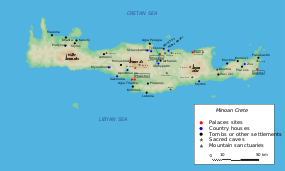 Map of Minoan Crete | |
| Location | Faistos, Heraklion, Crete, Greece |
|---|---|
| Region | Messara Plain |
| Coordinates | 35°03′32″N 24°47′33″E / 35.05889°N 24.79250°E |
| Type | Minoan town and "palace" |
| History | |
| Cultures | Minoan |
| Site notes | |
| Excavation dates | 1902-1914, 1934-1936, 1939, 1950, 1977-present |
| Archaeologists | Federico Halbherr, Luigi Pernier et al.[1] |
| Management | State[2] |
| Public access | Yes |
Hagia Triada (also Haghia Triada, Hagia Triadha, Ayia Triada, Agia Triada), (Greek: [aˈʝia triˈaða]) is a Minoan archaeological site in Crete. The site includes the remains of an extensive settlement noted for its monumental NeoPalatial and PostPalatial period buildings especially the large Royal Villa. It is located in the Mesara Plain about three kilometers from the larger Palace of Phaistos, with which it appears to have had close political and economic ties. It is also nearby the Minoan harbor site of Kommos.[3] Excavations at Hagia Triada have provided crucial evidence concerning Minoan everyday life.
Notable finds include the Hagia Triada sarcophagus and the "Harvester Vase". About 150 Linear A tablets were found, the largest cache at any Minoan site.[4] Twenty three roundels (circular lumps of clay sealed on the edge) and a large number of nodules (clay lumps with 3 faces of which two had small inscriptions and one face a seal) were also found.[5] All of the Linear A finds date to the Late Minoan IB period, before the site was destroyed by fire and then rebuilt.[6]
After being found on 62 Linear B tablets at Knossos, the name "pa-i-to" has been proposed for the ancient name of the nearby site of Phaistos. The ancient name of Hagia Triada is not yet known though at one point "da-wo" was proposed as well as Scheria from the writing of Homer.[7]
- ^ including Gaetano De Sanctis, Luisa Banti, Doro Levi, Clelia Laviosa, Vincenzo La Rosa
- ^ 23rd Ephorate of Prehistoric and Classical Antiquities
- ^ [1]Betancourt, P., "A Great Minoan Triangle: The Changing Characters of Phaistos, Hagia Triadha, and Kommos during the Middle Minoan-Late Minoan III Periods", in J.W. Shaw and Maria C. Shaw (eds.), pp. 31-34, 1985
- ^ [2] Salgarella, Ester, "Drawing lines: The palaeography of Linear A and Linear B", Kadmos, vol. 58, no. 1–2, pp. 61–92, 2019 doi:10.1515/kadmos-2019-0004
- ^ Massimo Perna, "The Roundels of Haghia Triada", Kadmos, 33, pp. 93-141 1994
- ^ [3]Tomas, Helena, "The Administration of Haghia Triada", Opvscvla archaeologica 25.1, pp. 39-57, 2001
- ^ Privitera, Santo, "Looking for a Home in a Houseless Town: Exploring Domestic Architecture in Final Palatial Ayia Triada", Hesperia Supplements, vol. 44, pp. 263–72, 2011